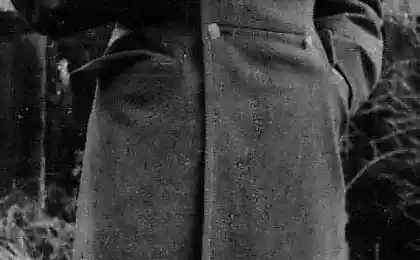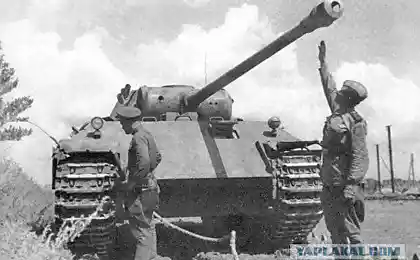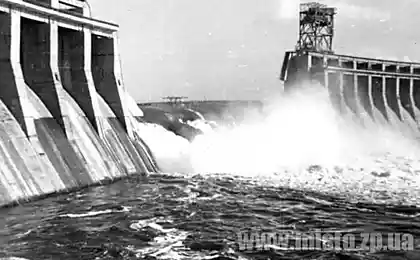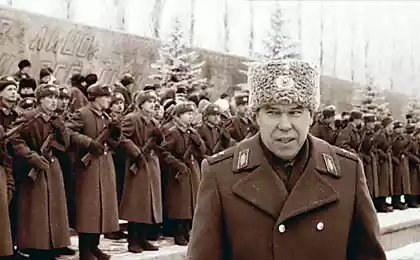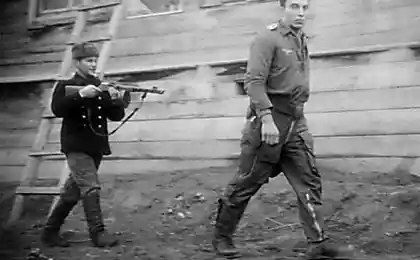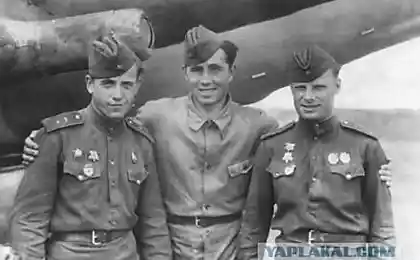586
Where did the Norfolk Regiment (4 photos + text)
About the mysterious disappearance of one battalion shot five of the Royal Norfolk Regiment in the First World were a lot of rumors and legends. Different sources give different figures, some argue that the 145 had disappeared, while others insist that more than 200. There are those that result in a figure of 2,000.
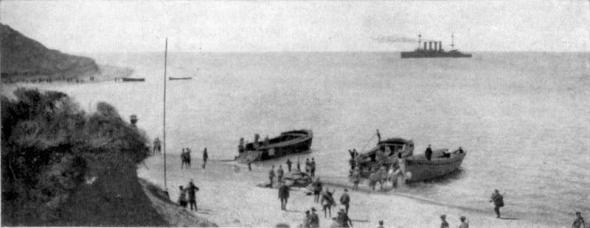
said event occurred August 21, 1915 during the ill-fated campaign at Gallipoli (European Turkey).
Norfolktsy entered in Gallipoli July 29, 1915. This campaign was designed to control the Dardanelles - a long, narrow channel, which stretches almost 65 km along the Turkish Gallipoli Peninsula and connects the Mediterranean and Black Seas. August 10, that is in the midst of the terrible summer heat vseissushayuschego, norfolktsy landed in the bay Sulva and saw the place has become the last refuge for many unfortunate soldiers.
Not far from the shores of the lake was salty. Drying up in the summer, it is unbearably shone in the sun a thick crust of salt crystals. Just behind the beach strip began the battlefield -ravnina Sulva bordered further chain of hills stretching from north to south and turn plain into a giant arena.
Gallipoli campaign was conducted in the most unfavorable theater of military operations, known to modern history; norfolktsev eyes and trying to convince themselves that they could get out of this adventure appeared nightmarish picture of this hell.
The conditions were terrible. The trenches were like a hot oven; scorching wind carried the stench of death and billowing clouds of dust over the valley. Food, trenches, dead bodies and latrines flooded disgusting fat green fly - "corpse flies", so called because they are huge hordes swarmed on the bodies of dead and wounded, terrible form of dysentery did not spare anyone, the soldiers in his eyes turned into walking skeletons. < br /> Troops depleted by the epidemic, have been depleted. Corpses lay everywhere in great abundance; hands and faces of the victims, here and there, sticking out of the sand, were terrible feature of the surrounding landscape. Morale fell, the troops was an atmosphere of hopelessness. But Sir Ian Hamilton, commander in chief of the Mediterranean Expeditionary Force, believed that the only chance to change the course of the campaign and win - will introduce new blood in the battles on the main line.
The operation began at 16 o'clock powerful artillery preparation, which lasted 45 minutes. However, the relationship is in poor condition and did not receive the necessary information artillery opened fire at the appointed time, but without a clear coordination purposes.
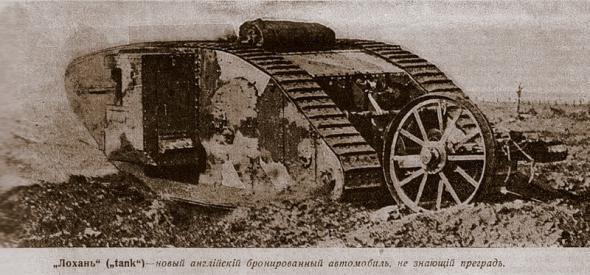
163rd Brigade, including a battalion of "one shot the four" not overcome the 900 meters and when it became obvious that the intention of crossing the open space in the light of the day turned out to be a serious mistake.
Immediately it became clear that the enemy had a much larger force than anticipated; continuous machine gun fire brigade was pressed to the ground. But on the right flank battalion of "one shot five" I have not met any serious resistance and continued to attack.
Here's how Sir Hamilton described the events that followed in a report to the Minister of War Lord Kitchener:
"In the course of the battle. honorably held the 163rd Brigade, there was a truly mysterious thing ... In the battle with the fiercely resisted the enemy Colonel Sir H. Beauchamp, an experienced and well-proven officer, steadily push forward the head of his battalion. The battle was hot and bloody, the land had been ripped open, many were wounded on the battlefield at night and only returned to their original positions. However, the Colonel with 16 officers and 250 soldiers continued to push the enemy. They went deep into the forest, and had neither seen nor heard. None of them is no longer seen, none of them came back ».
267 people disappeared without a trace!
And here is how commented on what he saw, for its part, twenty-two New Zealand infantry platoon from the third infantry company first:
"On the" height of 60 "and there are entrenched soldiers dropped, despite the gusty wind, a cloud of silver" mist ". It proved to be quite dense, almost "hard" and reached about eight feet long, two hundred and three hundred in height in width. Then marched to the British regiment, the first in the fourth division of the army Norfolk (actually it was the fifth regiment of the division 1/5 - approx. Aut.) - Apparently, sent in reinforcements to the parts were already there .. »

All the witnesses of what happened unanimously confirmed that several hundred soldiers entered the cloud descended on the road, it had disappeared and no one came from the opposite side.
About an hour later the "cloud" gradually rose and moved north to Bulgaria. And with him, obviously, and the regiment - two hundred and fifty men. In any case, the position does not have a single soldier. Norfolk Regiment was gone without a trace. All this happened in front of observers from other military units that have not heard any shots or sounds of a struggle. Their command of the reports came from the assumption that the missing soldiers were treacherously captured enemy prisoners ...
Here are the statements of soldiers ANZAC (Australian and New Zealand Army Corps) 4/165 FA Reyharta sapper sapper and 13/416 R. Nyunesa:
"The day was clear, what can only be a beautiful day on the Mediterranean. The picture is somewhat broken only by a few - 6 or 8 clouds in the form of a loaf of bread, everything exactly (quite) the same that hovered over the height of "60". It was observed that in spite of the breeze from the south, blowing at a speed of 4-5 miles / hour, the clouds did not change its position and shape, as well as being moved by the action of the breeze. They continued to hover at about 60, when viewed from our vantage point, situated at a height of 500 feet (above sea level).
In the same fixed, resting on the ground directly under the group of clouds, was similar in shape of a cloud, which had about 800 feet long, 250 feet high and 200 feet wide. This cloud was quite dense, almost solid-looking and are located at 14-15 Cheyne (Cheyne 1 = 6, 6 = 20 feet, 12 meters) from the British fought on the occupied territory. All this was observed 22 people 3 platoon of the 1st Field Company, including the I of our trenches on the spur of rhododendron, about 2,500 yards to the southwest from the clouds lying on the ground. Our observation post was located about 300 feet above the height of "60". As it turned out, this strange cloud saddled dry bed of the stream and the road in the recess Kayadzhik-dere, and we have seen great and the ends and sides of the clouds lying on the ground. His color was, like other clouds, light gray.
Soon, the Fourth Norfolk Regiment of the British, a few hundred people marching along the road of the deep valley of the stream in the direction of the height of "60". However, when they approached the cloud and without hesitation went on their way right through it, then no longer come out of it, to expand the order of battle and to fight for the height of "60". About an hour later, when the last person out of the column disappeared in the cloud, it is very slowly and gradually risen over the land like a normal fog or cloud is not yet joined the others in the same clouds, mentioned at the beginning of this report. Now they looked like "peas in a pod." All this time the band of clouds continued to hover in one place, but as soon as the strange "earthly" cloud rose to their level, they all moved off to the north, that is, Traits towards Bulgaria. For about 45 minutes they were out of sight.

We, the undersigned, declare that the incident described above - the truth of
word for word ».
Division officially brought in lists of "missing", and immediately after the Turkish surrender in 1918, Britain has demanded his return. Turks swore and swore that the regiment (and perhaps no one in the area), they are not a prisoner captured in fighting with him and did not engage in general did not even know of its existence.
The official report of the British campaign in the Dardanelles states that "the regiment was absorbed by the fog of uncertain origin." The mist that reflected the sun's rays so that blinded the gunners, gunners, because of which provide fire support failed. Two hundred and fifty people were missing.
In 1918, the British re-emerged on the Gallipoli Peninsula, but as a party, won the final victory in the war. A soldier of the occupation forces, bypassing the battlefield, discovered a badge of the Royal Norfolk Regiment and after a brief inquiry revealed that a certain Turkish peasants had to take from your site a lot of bodies, which he dumped in the nearest ravine. September 23, 1919 the officer in charge of the problems of burial, triumphantly reported:
"We found the Norfolk Battalion" one shot five "- all 185 Tel: 122 norfolktsa, the rest - from Cheshire Battalion" two shot four. " We were able to identify only the bodies of ordinary Barnaby and Carter. The bodies were scattered in the two and a half square kilometers (!!!), 750 meters behind the line of defense of the Turks. We found a farmer who discovered after the fight at home a lot of corpses of British soldiers and threw them into a small gorge. That is confirmed by the initial assumption that norfolktsy not gone deep into the enemy's defenses, but were gradually eliminated in the battlefield & quot ;.
More than strange statement because self-contradictory - 750 meters for "line of defense", this is not a battlefield, and almost a kilometer behind the front line.
Also surprising is the fact that out of 185 found, was identified only two.
What is found only 185 of the 267 (as stated in the statement of Hamilton) missing.
But the main thing is what kept it official sources, not just trying to explain the confusion and terror of this farmer, who insisted that the bodies found on their own field were badly mutilated.
"Broken, as if dropped from a great height ..." - so he described what happened. Frightened by the impure forces, he threw the body into a ravine.
And finally, I want to give a formal statement of the Turks in this regard:
& quot; ... during operation Galipolskoy Turkish side did not conduct any military operations in the area near the bay Sulva hollow Kayadzhik-Dere. As well as not being captured British soldiers throughout the fighting near the bay Sulva. & Quot;

said event occurred August 21, 1915 during the ill-fated campaign at Gallipoli (European Turkey).
Norfolktsy entered in Gallipoli July 29, 1915. This campaign was designed to control the Dardanelles - a long, narrow channel, which stretches almost 65 km along the Turkish Gallipoli Peninsula and connects the Mediterranean and Black Seas. August 10, that is in the midst of the terrible summer heat vseissushayuschego, norfolktsy landed in the bay Sulva and saw the place has become the last refuge for many unfortunate soldiers.
Not far from the shores of the lake was salty. Drying up in the summer, it is unbearably shone in the sun a thick crust of salt crystals. Just behind the beach strip began the battlefield -ravnina Sulva bordered further chain of hills stretching from north to south and turn plain into a giant arena.
Gallipoli campaign was conducted in the most unfavorable theater of military operations, known to modern history; norfolktsev eyes and trying to convince themselves that they could get out of this adventure appeared nightmarish picture of this hell.
The conditions were terrible. The trenches were like a hot oven; scorching wind carried the stench of death and billowing clouds of dust over the valley. Food, trenches, dead bodies and latrines flooded disgusting fat green fly - "corpse flies", so called because they are huge hordes swarmed on the bodies of dead and wounded, terrible form of dysentery did not spare anyone, the soldiers in his eyes turned into walking skeletons. < br /> Troops depleted by the epidemic, have been depleted. Corpses lay everywhere in great abundance; hands and faces of the victims, here and there, sticking out of the sand, were terrible feature of the surrounding landscape. Morale fell, the troops was an atmosphere of hopelessness. But Sir Ian Hamilton, commander in chief of the Mediterranean Expeditionary Force, believed that the only chance to change the course of the campaign and win - will introduce new blood in the battles on the main line.
The operation began at 16 o'clock powerful artillery preparation, which lasted 45 minutes. However, the relationship is in poor condition and did not receive the necessary information artillery opened fire at the appointed time, but without a clear coordination purposes.

163rd Brigade, including a battalion of "one shot the four" not overcome the 900 meters and when it became obvious that the intention of crossing the open space in the light of the day turned out to be a serious mistake.
Immediately it became clear that the enemy had a much larger force than anticipated; continuous machine gun fire brigade was pressed to the ground. But on the right flank battalion of "one shot five" I have not met any serious resistance and continued to attack.
Here's how Sir Hamilton described the events that followed in a report to the Minister of War Lord Kitchener:
"In the course of the battle. honorably held the 163rd Brigade, there was a truly mysterious thing ... In the battle with the fiercely resisted the enemy Colonel Sir H. Beauchamp, an experienced and well-proven officer, steadily push forward the head of his battalion. The battle was hot and bloody, the land had been ripped open, many were wounded on the battlefield at night and only returned to their original positions. However, the Colonel with 16 officers and 250 soldiers continued to push the enemy. They went deep into the forest, and had neither seen nor heard. None of them is no longer seen, none of them came back ».
267 people disappeared without a trace!
And here is how commented on what he saw, for its part, twenty-two New Zealand infantry platoon from the third infantry company first:
"On the" height of 60 "and there are entrenched soldiers dropped, despite the gusty wind, a cloud of silver" mist ". It proved to be quite dense, almost "hard" and reached about eight feet long, two hundred and three hundred in height in width. Then marched to the British regiment, the first in the fourth division of the army Norfolk (actually it was the fifth regiment of the division 1/5 - approx. Aut.) - Apparently, sent in reinforcements to the parts were already there .. »

All the witnesses of what happened unanimously confirmed that several hundred soldiers entered the cloud descended on the road, it had disappeared and no one came from the opposite side.
About an hour later the "cloud" gradually rose and moved north to Bulgaria. And with him, obviously, and the regiment - two hundred and fifty men. In any case, the position does not have a single soldier. Norfolk Regiment was gone without a trace. All this happened in front of observers from other military units that have not heard any shots or sounds of a struggle. Their command of the reports came from the assumption that the missing soldiers were treacherously captured enemy prisoners ...
Here are the statements of soldiers ANZAC (Australian and New Zealand Army Corps) 4/165 FA Reyharta sapper sapper and 13/416 R. Nyunesa:
"The day was clear, what can only be a beautiful day on the Mediterranean. The picture is somewhat broken only by a few - 6 or 8 clouds in the form of a loaf of bread, everything exactly (quite) the same that hovered over the height of "60". It was observed that in spite of the breeze from the south, blowing at a speed of 4-5 miles / hour, the clouds did not change its position and shape, as well as being moved by the action of the breeze. They continued to hover at about 60, when viewed from our vantage point, situated at a height of 500 feet (above sea level).
In the same fixed, resting on the ground directly under the group of clouds, was similar in shape of a cloud, which had about 800 feet long, 250 feet high and 200 feet wide. This cloud was quite dense, almost solid-looking and are located at 14-15 Cheyne (Cheyne 1 = 6, 6 = 20 feet, 12 meters) from the British fought on the occupied territory. All this was observed 22 people 3 platoon of the 1st Field Company, including the I of our trenches on the spur of rhododendron, about 2,500 yards to the southwest from the clouds lying on the ground. Our observation post was located about 300 feet above the height of "60". As it turned out, this strange cloud saddled dry bed of the stream and the road in the recess Kayadzhik-dere, and we have seen great and the ends and sides of the clouds lying on the ground. His color was, like other clouds, light gray.
Soon, the Fourth Norfolk Regiment of the British, a few hundred people marching along the road of the deep valley of the stream in the direction of the height of "60". However, when they approached the cloud and without hesitation went on their way right through it, then no longer come out of it, to expand the order of battle and to fight for the height of "60". About an hour later, when the last person out of the column disappeared in the cloud, it is very slowly and gradually risen over the land like a normal fog or cloud is not yet joined the others in the same clouds, mentioned at the beginning of this report. Now they looked like "peas in a pod." All this time the band of clouds continued to hover in one place, but as soon as the strange "earthly" cloud rose to their level, they all moved off to the north, that is, Traits towards Bulgaria. For about 45 minutes they were out of sight.

We, the undersigned, declare that the incident described above - the truth of
word for word ».
Division officially brought in lists of "missing", and immediately after the Turkish surrender in 1918, Britain has demanded his return. Turks swore and swore that the regiment (and perhaps no one in the area), they are not a prisoner captured in fighting with him and did not engage in general did not even know of its existence.
The official report of the British campaign in the Dardanelles states that "the regiment was absorbed by the fog of uncertain origin." The mist that reflected the sun's rays so that blinded the gunners, gunners, because of which provide fire support failed. Two hundred and fifty people were missing.
In 1918, the British re-emerged on the Gallipoli Peninsula, but as a party, won the final victory in the war. A soldier of the occupation forces, bypassing the battlefield, discovered a badge of the Royal Norfolk Regiment and after a brief inquiry revealed that a certain Turkish peasants had to take from your site a lot of bodies, which he dumped in the nearest ravine. September 23, 1919 the officer in charge of the problems of burial, triumphantly reported:
"We found the Norfolk Battalion" one shot five "- all 185 Tel: 122 norfolktsa, the rest - from Cheshire Battalion" two shot four. " We were able to identify only the bodies of ordinary Barnaby and Carter. The bodies were scattered in the two and a half square kilometers (!!!), 750 meters behind the line of defense of the Turks. We found a farmer who discovered after the fight at home a lot of corpses of British soldiers and threw them into a small gorge. That is confirmed by the initial assumption that norfolktsy not gone deep into the enemy's defenses, but were gradually eliminated in the battlefield & quot ;.
More than strange statement because self-contradictory - 750 meters for "line of defense", this is not a battlefield, and almost a kilometer behind the front line.
Also surprising is the fact that out of 185 found, was identified only two.
What is found only 185 of the 267 (as stated in the statement of Hamilton) missing.
But the main thing is what kept it official sources, not just trying to explain the confusion and terror of this farmer, who insisted that the bodies found on their own field were badly mutilated.
"Broken, as if dropped from a great height ..." - so he described what happened. Frightened by the impure forces, he threw the body into a ravine.
And finally, I want to give a formal statement of the Turks in this regard:
& quot; ... during operation Galipolskoy Turkish side did not conduct any military operations in the area near the bay Sulva hollow Kayadzhik-Dere. As well as not being captured British soldiers throughout the fighting near the bay Sulva. & Quot;
